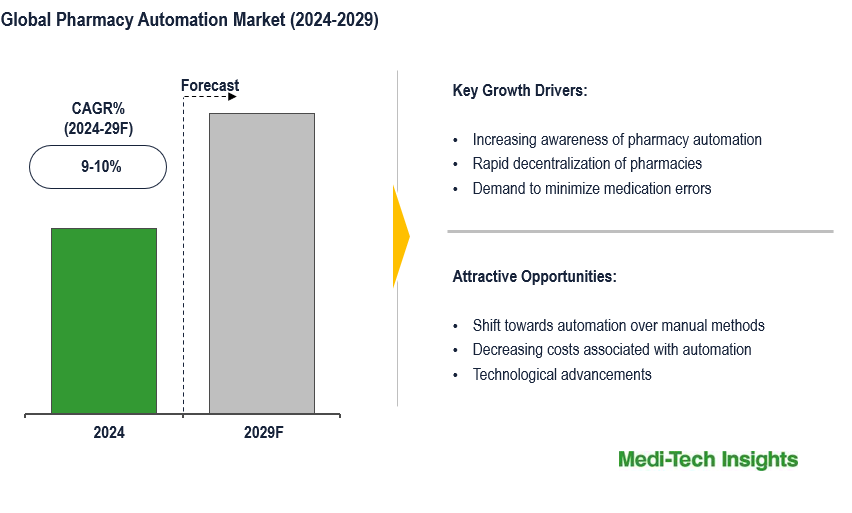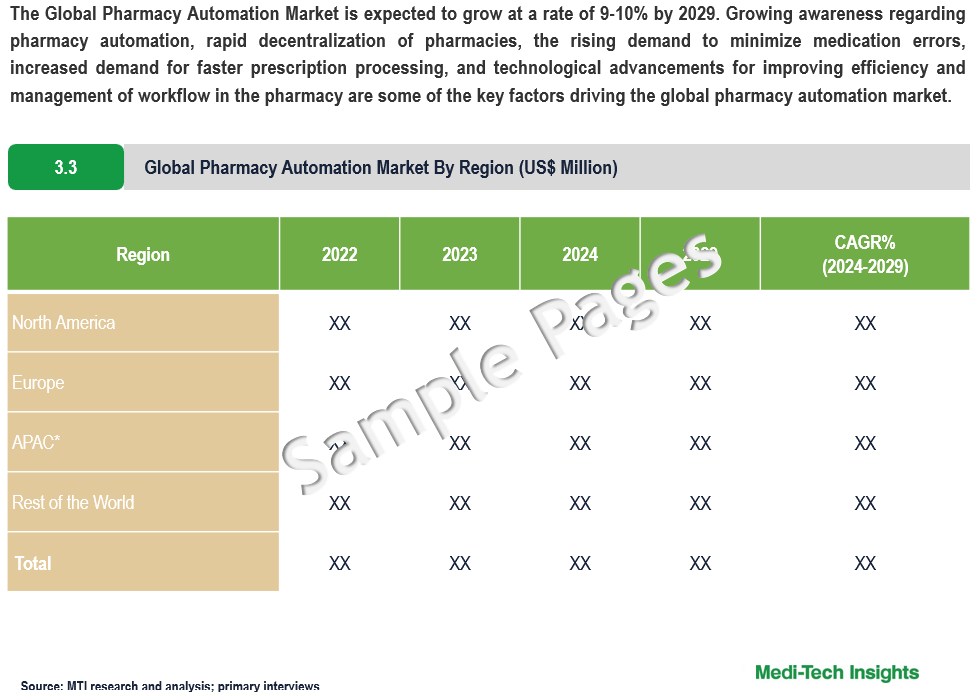
Pharmacy Automation Market: Global Industry Analysis, Size, Trends, Share, and Technological Advancements for Forecast 2024–2029
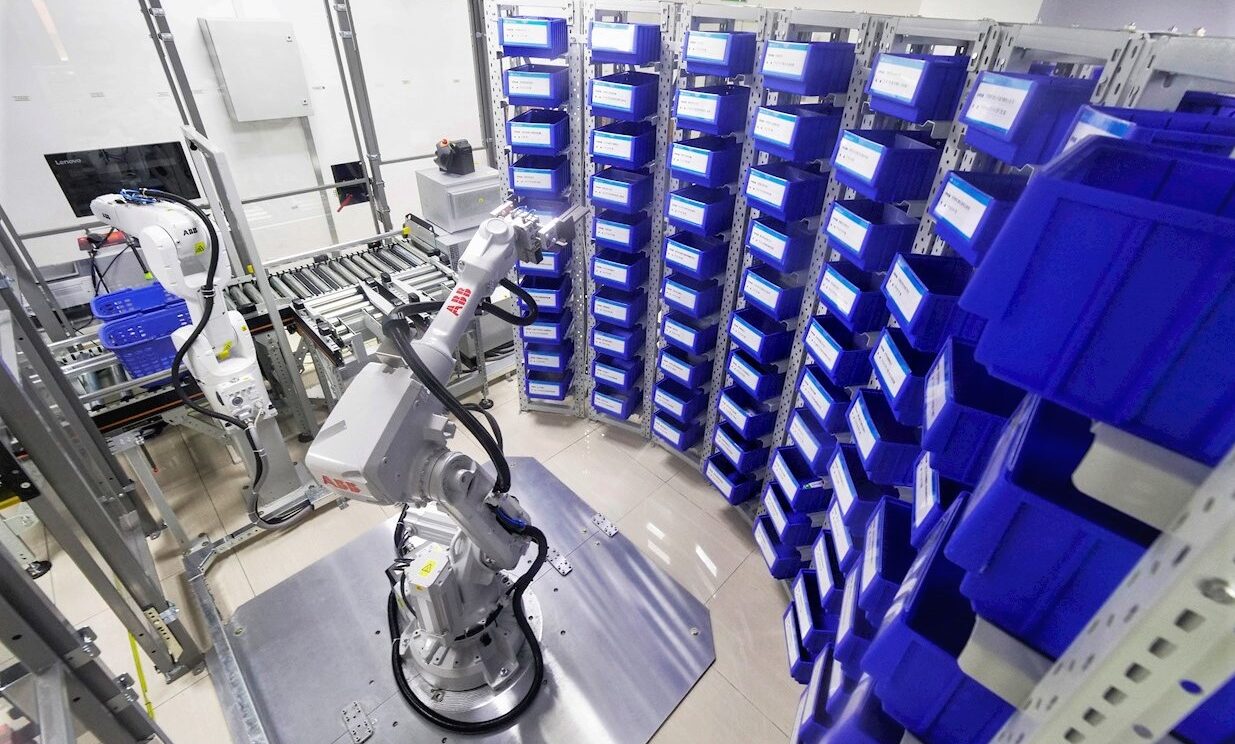
The Global Pharmacy Automation Market is expected to grow 9-10% by 2029. Growing awareness regarding pharmacy automation, rapid decentralization of pharmacies, the rising demand to minimize medication errors, increased demand for faster prescription processing, and technological advancements for improving efficiency and management of workflow in the pharmacy are some of the key factors driving the global pharmacy automation market. To learn more about the research report, download a sample report.
Pharmacy automation is a mechanical system that performs operations involving the storage, packaging, dispensing, or distribution of medications while enabling control of the operation and electronic documentation of transactions. It allows pharmacies to streamline workflows and reduce the risk of errors. Nowadays, pharmacies are incorporating several types of automation into their workflow to improve efficiency, minimize labor costs, and improve accuracy. Some of the automation currently used by pharmacies include:
- Counting pills or capsules or measuring liquid medication
- Compounding
- Inventory management and reordering of medications when supply gets low
- Contacting physicians for refills or clarifications
- Transcribing patient or physician phone messages
- Entering or updating patients' personal or insurance information
- Identifying potentially dangerous medication interactions
- Automated phone calls informing patients their prescriptions are ready to pick up
The Advent of Advanced Pharmacy Automation Technologies Drives the Pharmacy Automation Market
The technology behind automated systems has advanced over the past several years and has witnessed developments such as advancements in software, artificial intelligence & machine learning, and solutions for pharmaceutical purposes. Advancement in digital technologies enables pharmacies to handle high prescription loads safely and efficiently. When pharmacy automation first became popular, pill counting was one of the only techniques available in the market. Nowadays, there are several more accessible automation machines available some of them include, automated medication dispensing systems, automated storage and retrieval systems, automated packaging and labelling systems, table-top tablet counters, and automated compounding devices. Recently, several technological developments have been made to improve the common tasks and processes performed in a pharmacy or other healthcare settings such as:
- In July 2023, Deenova successfully launched its newest product line, AIDE, by partnering with Longjumeau Hospital in France to deploy the AIDE-CUT automation robot for unit dose medication repackaging and the AIDE-PICK automated patient therapy dispensation robot, both aimed at enhancing operational efficiency and ensuring full medication traceability
- In April 2023, Spital Bülach introduced the autonomous delivery robot Relay, designed with advanced sensor technology to minimize mundane transport tasks for nursing staff by autonomously transporting medicines, blood, and laboratory samples throughout the hospital
- In March 2022, Capsa Healthcare announced an expansion to its suite of NexsysADC automated dispensing cabinets. NexsysADC can accommodate any size of controlled or high-value medications or supplies in two new sizes of Controlled Access Module Drawers.
- In August 2021, Innovation Associates announced the launch of its Smart-Pod, a next-generation robot for central-fill pharmacy environments. Smart-Pod allows providers to adjust and scale their centralized fulfilment solutions to meet demands.
To learn more about this report, download the PDF brochure
Switch towards Pharmacy Automation System over Manual Methods
In the pharmacy system, various processes such as tablet counting, IV dosage fillings, medicine dispensing, etc. were done manually. The manual method used many workers, extra time in completion of the work, errors were common in these processes. But as the benefits offered by pharmacy automation grew clearer, even traditionalist pharmacies have started to make the switch. Automation increases a pharmacy’s efficiency while dramatically reducing its rate of error. It frees up human pharmacists to perform important tasks like interacting with patients face to face, which can’t be delegated to a machine. Also, the costs associated with automation continue to drop, and more pharmacies are realizing that they can’t afford to put off automation any longer. Moving towards an automation system creates several operational benefits for a pharmacy which in turn is expected to boost the market in the coming years. For instance,
- In November 2023, Omnicell, Inc. announced that Kentucky-based Baptist Health has adopted Omnicell’s Central Pharmacy Dispensing Service to address labor challenges and improve clinical and financial outcomes by leveraging advanced robotics, dispensing optimization tools, and expert support to enhance safety, accuracy, and workflow efficiency, significantly reducing the time pharmacists spend on dispensing tasks.
- In July 2023, Deenova announced their collaboration with AOU Parma to implement RFID traceability systems for medical devices at the Parma University Hospital, highlighting the proven benefits of this technology
“New pharmacy automation systems are emerging to address the growing demand for medicine in the world. Technology has a key role to play. An advancement in digital technologies enables pharmacies to handle high prescription loads safely and efficiently.” -Vice President, Global Operations and Supply Chain, Pharmacy Automation Company, United States
Product Segment Outlook
The global pharmacy automation market is segmented into products, software, and services, each playing a vital role in enhancing efficiency and patient care within pharmacies worldwide. Pharmacy automation systems, including medication dispensing systems, automated storage and retrieval systems, and packaging and labeling systems, represent the largest share of the market. These systems automate various tasks such as inventory management, medication dispensing, and prescription filling, reducing errors and improving workflow efficiency. Pharmacy automation software, which includes inventory management software, workflow management software, and prescription management software, is also a significant segment, facilitating seamless integration and operation of automation systems while optimizing inventory and workflow processes. Furthermore, pharmacy automation services, such as installation, maintenance, and training services, complement the adoption of automation solutions, ensuring smooth implementation and ongoing support for pharmacies transitioning to automated environments.
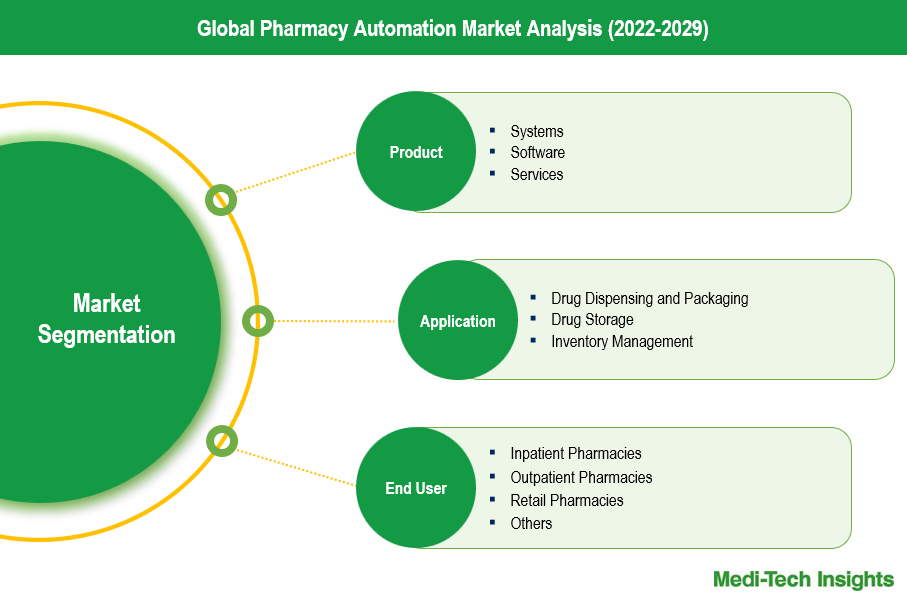
To learn more about this report, download the PDF brochure
Application Outlook
In the global pharmacy automation market, the product segment is diversified into several key categories, with drug dispensing and packaging systems, drug storage solutions, and inventory management technologies playing pivotal roles. Drug dispensing and packaging systems constitute a significant share of the market, offering automated solutions for the accurate and efficient dispensing and packaging of medications. These systems encompass various technologies, including automated pill dispensers, robotic prescription filling systems, and unit-dose packaging machines, which streamline medication dispensing processes while minimizing errors and improving patient safety. Drug storage solutions, another essential product segment, include automated medication storage and retrieval systems, medication refrigeration units, and medication carousel systems, enabling pharmacies to efficiently organize and store medications while optimizing space utilization and inventory control. Inventory management technologies, such as barcode scanners, RFID tracking systems, and inventory management software, are also integral components of the pharmacy automation market, facilitating real-time tracking, monitoring, and replenishment of medication stocks, thereby enhancing operational efficiency and reducing medication stockouts and wastage.
North America Likely to Continue its Dominance in the Coming Years in Pharmacy Automation Market
From a geographical perspective, North America holds a major market share of the pharmacy automation market. Increasing adoption of new automation technologies in hospitals and pharmacies, rising number of drug prescriptions at pharmacies stemmed from growth in the aging and obese population, a surge in the need to reduce prescription & dispensing errors, the need for improving efficiency and management of workflow in the pharmacy, and an increasing number of hospitals and healthcare laboratories in this region are expected to drive the market. APAC is also expected to witness strong growth in the coming years, due to an increase in the number of EHRs (Electronic Health Records), a rise in the volume of e-prescriptions, and computerized physician order entry (CPOE) in the healthcare facilities, growth in healthcare expenditure in emerging countries, and technological advancements for improving the workflow of pharmacy automation system in hospitals and pharmacies in this region.
Competitive Landscape Analysis: Pharmacy Automation Market
Some of the key players operating in the pharmacy automation market include Becton Dickinson and Company, Omnicell Inc., KUKA AG, Baxter International Inc., Capsa Healthcare, Cerner Corporation, Yuyama Co. Ltd., Arxium Inc., Parata Systems LLC, RxSafe LLC, ScriptPro LLC, Deenova S.R.L, TouchPoint Medical Solutions, Pearson Medical Technologies LLC, McKesson Corporation, Noritsu Pharmacy Automation, Medical Packaging Inc., Innovation Associates (iA), MedAvail, Swisslog Healthcare, Pharmacy Automation System, Meditech Pharmacy Management Solutions, and Amerisource Bergen Corporation, among others.
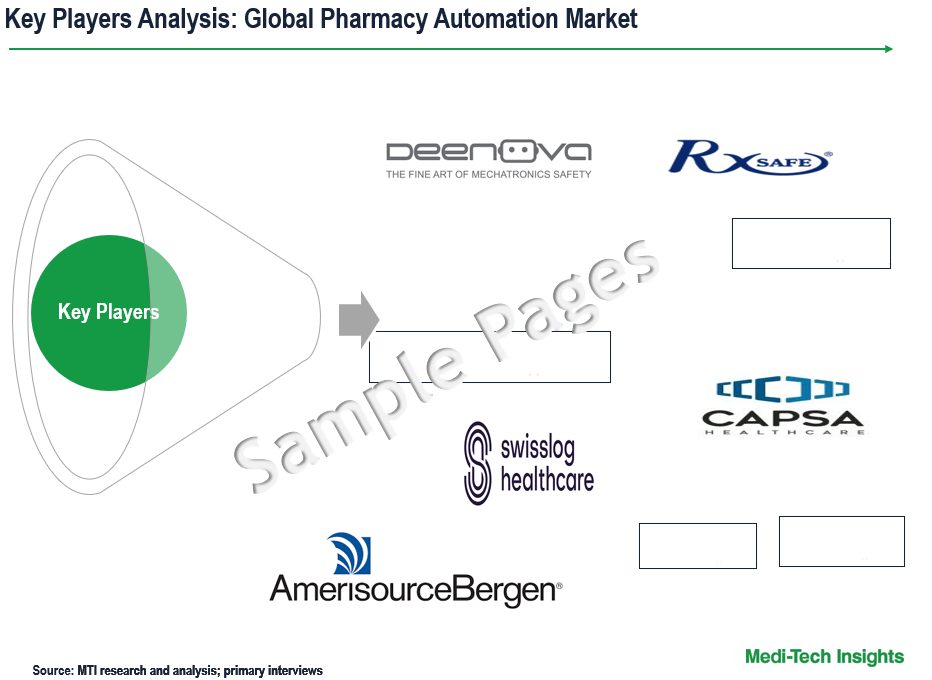
Get a sample report for competitive landscape analysis
Organic and Inorganic Growth Strategies Adopted by Players to Establish Their Foothold in the Market
Players operating in this market are adopting both organic and inorganic growth strategies such as collaborations, acquisitions, and new product launches to garner market share. For instance,
- In May 2024, iA unveiled its newly renovated national headquarters, which includes an Innovation Hub, the first of its kind in the industry, featuring an advanced central pharmacy fulfillment technology center and training facility for pharmacy workers
- In May 2022, Deenova announced the launch of its innovative Pay-Per-Dose unit dose pharmacy automation service to the UK market. Deenova is the first company to bring a fully automated, closed-loop solution for the management of medication and medical supplies to the UK.
- In February 2022, Capsa Healthcare announced the acquisition of Humanscale Healthcare, a designer and manufacturer of flexible technology solutions and computing workstations based in New York. Combined, Capsa will now offer the broadest product suite in the market and expands its ability to provide ergonomically tailored point-of-care computing solutions to healthcare partners worldwide.
- In December 2021, Omnicell Inc. announced the acquisition of ReCept Holdings Inc., along with its specialty pharmacy management services for health systems, provider groups, and federally qualified health centers (FQHCs), to expand its advanced services portfolio.
- In November 2021, Swisslog Healthcare and Centre Hospitalier - Le Mans, entered into an innovation agreement to synergize their expertise in the pharmacy field through the automated packaging and dispensing system, TheraPick.
- In September 2021, Deenova and Marien Hospital, entered into a contract where Dennova will be providing installation and full service/support for 3 All-in-1 Packaging Robots, 34 All-in-1 Station Medication Dispensing Robots, and 72 All-in-1 Trolleys with secure bed-side verification to Marien Hospital and also launched its operations in Europe's largest GDP health care market.
The global pharmacy automation market is a growing market that is expected to gain further momentum in the coming years due to technological advancements, stringent government regulations, new product launches, and aggressive organic and inorganic growth strategies followed by the players.
| Report Scope | Details |
| Base Year Considered | 2023 |
| Historical Data | 2022 - 2023 |
| Forecast Period | 2024 - 2029 |
| CAGR (2024 - 2029) | 9-10% |
| Segment Scope | Product, Application, End User |
| Regional Scope |
|
| Key Companies Mapped | Becton Dickinson and Company, Omnicell Inc., KUKA AG, Baxter International Inc., Capsa Healthcare, Cerner Corporation, Yuyama Co. Ltd., Arxium Inc., Parata Systems LLC, RxSafe LLC, ScriptPro LLC, Deenova S.R.L, TouchPoint Medical Solutions, Pearson Medical Technologies LLC, McKesson Corporation, CareFusion, Noritsu Pharmacy Automation, Medical Packaging Inc., Innovation Associates (iA), MedAvail, Swisslog Healthcare, Pharmacy Automation System, Meditech Pharmacy Management Solutions, Medacist Solutions Group LLC, and Amerisource Bergen Corporation among others |
| Report Highlights | Market Size & Forecast, Growth Drivers & Restraints, Trends, Competitive Analysis |
Key Strategic Questions Addressed
-
What is the market size & forecast for the Global Pharmacy Automation Market?
-
What are the historical, present, and forecasted market shares and growth rates of various segments and sub-segments of the Global Pharmacy Automation Market?
-
How has COVID-19 impacted the Global Pharmacy Automation Market?
-
What are the major growth drivers, restraints/challenges impacting the market?
-
What are the opportunities prevailing in the market?
-
What is the investment landscape?
-
Which region has the highest share in the global market? Which region is expected to witness the highest growth rate in the next 5 years?
-
Who are the major players operating in the market? What is the competitive positioning of key players?
-
Who are the new players entering the market?
-
What are the key strategies adopted by players?
- Research Methodology
- Secondary Research
- Primary Research
- Market Estimation
- Market Forecasting
- Executive Summary
- Market Overview
- Market Dynamics
- Drivers
- Restraints
- Key Market Trends
- Market Dynamics
-
- Industry Speaks
- Key Revenue Pockets
- Global Pharmacy Automation Market - Size & Forecast (2021-2028), By Product
- Systems
- Software
- Services
- Global Pharmacy Automation Market - Size & Forecast (2021-2028), By Pharmacy Size
- Large Size Pharmacy
- Medium Size Pharmacy
- Small Size Pharmacy
- Global Pharmacy Automation Market - Size & Forecast (2021-2028), By Application
- Drug Dispensing and Packaging
- Drug Storage
- Inventory Management
- Global Pharmacy Automation Market - Size & Forecast (2021-2028), By End User
- Inpatient Pharmacies
- Outpatient Pharmacies
- Retail Pharmacies
- Online Pharmacies
- Others
- Global Pharmacy Automation Market - Size & Forecast (2021-2028), By Region
- North America (U.S. & Canada)
- Europe (UK, Germany, France, Italy, Spain, Rest of Europe)
- Asia Pacific (China, India, Japan, Rest of Asia Pacific)
- Rest of the World (Latin America, Middle East & Africa)
- Competitive Landscape
- Key Players and their Competitive Positioning
- Competitive Positioning of Key Players (2022)
- Offerings Assessment, By Player
- Key Strategies Assessment, By Player (2021-2023)
- New Product & Service Launches
- Partnerships, Agreements, & Collaborations
- Mergers & Acquisitions
- Geographic Expansion
- Key Players and their Competitive Positioning
- Key Companies Scanned (Indicative List)
- Becton Dickinson and Company
- Omnicell Inc.
- KUKA AG
- Baxter International Inc.
- Capsa Healthcare
- Cerner Corporation
- Yuyama Co. Ltd.
- Arxium Inc.,
- Parata Systems LLC
- RxSafe LLC
- ScriptPro LLC
- Deenova S.R.L
- TouchPoint Medical Solutions
- Pearson Medical Technologies LLC
- McKesson Corporation
- Noritsu Pharmacy Automation
- Medical Packaging Inc.
- Innovation Associates (iA)
- MedAvail
- Swisslog Healthcare
- Pharmacy Automation System
- Meditech Pharmacy Management Solutions
- Amerisource Bergen Corporation
- Other Prominent Players
The study has been compiled based on extensive primary and secondary research.
Secondary Research (Indicative List)
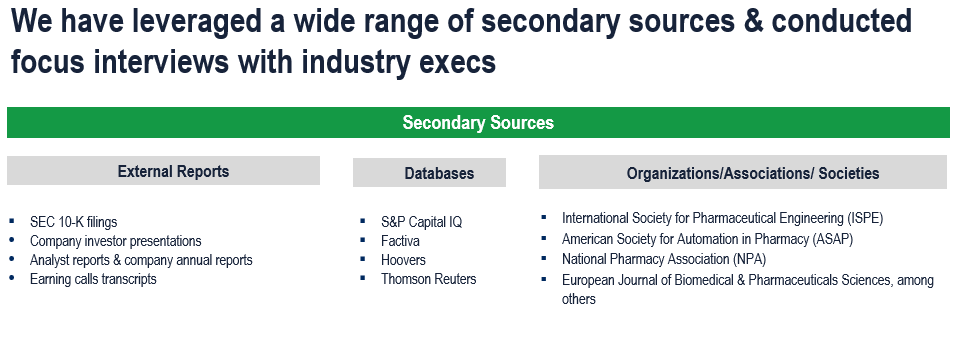
Primary Research
To validate research findings (market size & forecasts, market segmentation, market dynamics, competitive landscape, key industry trends, etc.), extensive primary interviews were conducted with both supply and demand-side stakeholders.
Supply Side Stakeholders:
- Senior Management Level: CEOs, Presidents, Vice-Presidents, Directors, Chief Technology Officers, Chief Commercial Officers
- Mid-Management Level: Product Managers, Sales Managers, Brand Managers, Business Development Managers, Consultants
Demand Side Stakeholders:
- Stakeholders in Hospitals Pharmacies, Clinic Pharmacies, Mail Order Pharmacies, Retail Pharmacies, Inpatient Pharmacies, Outpatient Pharmacies, Pharmacy Benefit Management and Other End Users
Breakdown of Primary Interviews
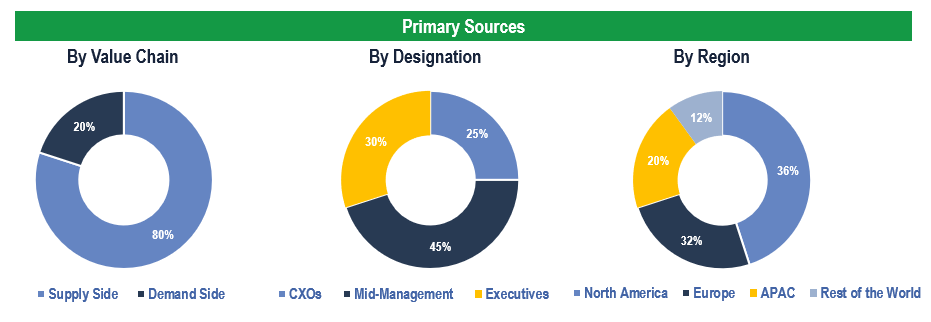
Market Size Estimation
Both ‘Top-Down and Bottom-Up Approaches’ were used to derive market size estimates and forecasts.
Data Triangulation
Research findings derived through secondary sources & internal analysis were validated with Primary Interviews, Internal Knowledge Repository, and Company Sales Data.

